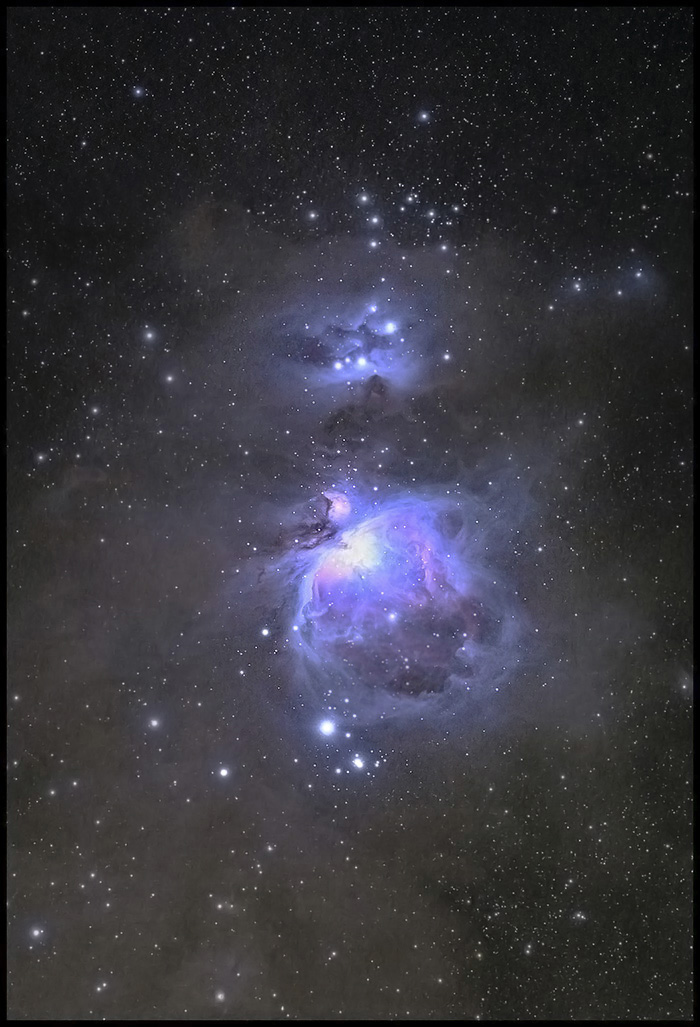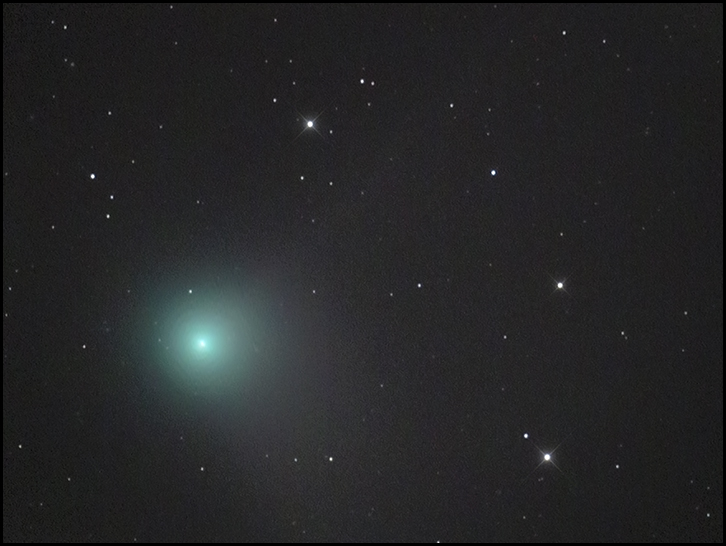Orion, waiting for Catalina
I waited up for the comet, but Orion stole the show.
01/03/2016. I wanted to give the 10-inch Newtonian a chance to show what it could do with Comet Catalina. I set up in the cul de sac in the evening and figured some time with the Great Orion Nebula and environs would be well spent. I started with the little AT65EDQ on the G11, unguided.

M42 and its extended molecular cloud
AT65EDQ, Canon 6D
49x30s ISO 3200, unguided
Aligned, stacked etc in Pixinsight
Click the image for a better view.
That's fairly tightly cropped. The original extends all the way up to the Horsehead which is neatly cut in two by the northeast edge of the frame. Another night. Also, individual subs show constellations of geosynchronous satellites parked 25,000 miles above the Caribbean.
What I was really waiting for was Comet Catalina. So I removed the AT65EDQ from the G11, mounted the 10-inch, adjusted the counterweights, popped on an 8x50 finder, and came back down to play with the M42 data until time to go catch the comet. Reduction took a solid three hours in Pixinsight, most of it CPU bound. Really need a faster system for that package.
From 3:45 - 4:30, in 14x70 binoculars, Catalina was just a less defined version of nearby M3. A little bigger, no brighter. No tail visible. A rising crescent Moon about 30 degrees from the comet did more to dull the view than I expected, but I don't think that fully accounts for Catalina's reduced state. I shortened my subexposures to 20s in deference to the brighter sky and fast reflector. I was amazed that it was tough to tell where the tails of Catalina were even in the bright subexposures. I shot the comet in three positions in the field, just to make sure I got all there was to see. The ion tail extends (dimly) to the upper right; the dust tail is a very broad fan to the right and lower right. Squint.
For what it's worth, here you go:

Comet Catalina
15x20s, 10-inch F4, Canon 6D, ISO 3200
That, too, is pretty tightly cropped for two reasons: there's not a lot more to see, and I didn't collect a good flat field with which to calibrate the full frame.
Nice that the G11 is working so well. In fact, transporting it in a Pelican 1620 has been remarkably convenient. So much so that I shopped up a cheap Pelican 1650 for the A-P Mach1 (hint: shop for big Peli cases as SCUBA gear rather than as photographic gear; divers are not the spendthrifts we optical fetishists appear to be). Anyway, the A-P is sold as a portable mount, and I may as well use it as such. Also, while its heavy-duty cover works like a charm, I'd still feel better if it and its electronics spent more time indoors, so the case will be for both storage and transportation.
1/8/2016. You know, looking over the last few months' work, I think the astrophotos I'm getting using the 6D and little AT65EDQ are among the best I've ever made. I routinely complain only that I need darker skies and longer exposures. A pleasant enough drive can supply the former, and with the Mach1 rendered portable, especially with the RAPAS alignment tool, I can probably routinely shoot five minute unguided subs with the AT65EDQ. For that matter, guiding for one night is not a problem except for the extra 15 minutes to set up the computer and guide-scope (after that, power needs to be considered). Tomorrow I'll take the Mach1 off its semi-permanent mount and make sure it's comfortable in its new-to-me Pelican case. Then let's think about a night in the dark.
1/10/2016. I found tons of room in the Pelican 1650 for the Mach1, its counterweights and its counterweight shaft, shaft extension, and electronics. There's room for so much stuff I can't begin to move it! So make sure that when it is in the Honda's trunk, it will open far enough to remove at least the counterweights and shafts before removing the case to get at the mount itself. I brought it inside and gave it a thorough cleaning. I put the RAPAS on the Mach1 so that it can be realigned casually. You know all those industrial carpet squares downstairs? Line the Mach1's case with one of those.
Thus inspired, I reworked the G11's traveling arrangements, too: I shortened the legs by another couple of inches so that they just fit inside the Pelican 1620 with the G11 head in the Honda's trunk (they're still longer than the short legs under the Mach1 on its trailer). That saves room and much clanking in the trunk and expedites unpacking at very little expense in lifting weight. In the same vein, I ordered two soft-side toolbags and one plastic toolbox from Amazon (for A-P electronics, A-P counterweights, and G11 counterweights, respectively). The soft bags should fit inside the 1650 with the Mach1; the toolbox will ride beside the G11's Pelican. I also drilled out all three holes in the Losmandy tripod top assigned to the G11 to provide room to mount the head without fiddling and fighting with bolt aligments. I'll probably do the same for the Losmandy tripod top associated with the Mach1. Finally for today, I removed the Velcro the former owner applied to the tripod top, sanded it, and painted some of it bronze. Just because.
Next time you see a hardware store, pocket some extra fender washers and a couple of 5/16 Allen wrenches; stash them witih the Mach1 to assist in mounting and dismounting it. See how many landscaping tiles will be needed to put short piers under the Mach1 tripod after the trailer is put on waivers.
Tonight, revisiting Orion (assuming the weather holds).
Except where noted, deep-sky photos are made with an SBIG ST2000XM CCD behind a 10-inch Astro-Tech Ritchey-Chretien carried on an Astro-Physics Mach1GTO. The CCD is equipped with Baader wide- and narrow-band filters. The internal guide chip of the CCD most often keeps the OTA pointed in the right direction (I'll let you know when an OAG or guidescope takes its place). Camera control and guiding are handled by Maxim DL 5.12. The stock focuser on the AT10RC has been augmented with Robofocus 3.0.9 using adapters turned on the lathe downstairs. A Canon 6D and a modded 50D find themselves mounted on an Orion 10" F4 Newtonian or carrying widefield glass on an iOptron Skytracker. Beginning in May 2013, PixInsight has taken over more and more of the heavy lifting -- alignment, stacking, gradient removal, noise-reduction, transfer function modification, color calibration, and deconvolution. Photoshop CS4 et seq and the Focus Magic plugin get their licks in, too.
:: top ::